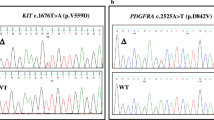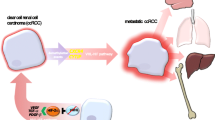Abstract
Nephroblastoma prognosis has dramatically improved, but an unfavourable prognostic subgroup warrants development of novel therapeutic strategies. Selective KIT, PDGFRα and epidermal growth factor receptor (EGFR) tyrosine kinase inhibition evolved as powerful targeted therapy for gastrointestinal stromal tumours and non-small-cell lung cancer. To investigate a potential role for tyrosine kinase inhibition, we analyzed 209 nephroblastomas for immunohistochemical KIT and EGFR expression, 63 nephroblastomas for mutations in KIT exons 9, 11, 13, EGFR exons 18, 19, 20 and 21, and all 209 nephroblastomas for PDGFRα exons 12, 14 and 18. Twenty-two tumours (10.5%) expressed KIT, 31 (14.8%) EGFR, and 10 (4.8%) both KIT and EGFR, respectively. KIT expression was relatively more common among high-risk tumours (6/27; 22.3%) compared to low-/intermediate-risk tumours (26/181; 14.4%). Nine patients deceased, four of which had high-risk tumours with KIT expression in two of four and EGFR expression in one of four. There were no KIT, PDGFRα or EGFR mutations. Our results suggest no significant contribution of KIT, EGFR or PDGFRα mutations to nephroblastoma pathogenesis. Despite a trend towards association of immunohistochemical KIT and EGFR expression with poor outcome in high-risk nephroblastomas, statistical analysis did not yield significant correlations in this subgroup. Therefore, it remains open if KIT, PDGFRα or EGFR tyrosine kinase inhibition constitute a therapeutic target in nephroblastoma in the absence of KIT, PDGFRα or EGFR mutations.





Similar content being viewed by others
References
Alpers CE, Hudkins KL, Ferguson M, Johnson RJ, Rutledge JC (1995) Platelet-derived growth factor A—chain expression in developing and mature human kidneys and in Wilms’ tumor. Kidney Int 48(1):146–154
Buchdunger E, Cioffi CL, Law N, Stover D, Ohno-Jones S, Druker BJ, Lydon NB (2000) Abl protein-tyrosine kinase inhibitor STI571 inhibits in vitro signal transduction mediated by c-kit and platelet-derived growth factor receptors. J Pharmacol Exp Ther 295:139–145
Charles AK, Brown KW, Berry PJ (1998) Microdissecting the genetics events in nephrogenic rests and Wilms tumor development. Am J Pathol 153:991–1000
Chirieac RL, Trent JC, Steinert DM, Choi H, Yang Y, Zhang J, Patel SR, Benjamin RS, Raymond AK (2006) Correlation of immunophenotype with progression-free survival in patients with gastrointestinal stromal tumors treated with imatinib mesylate. Cancer 107:2237–2244
Cho BC, Im CK, Park MS, Kim SK, Chang J, Park JP, Choi HJ, Kim YJ, Shin SJ, Sohn JH, Kim H, Kim JH (2007) Phase II study of erlotinib in advanced non-small-cell lung cancer after failure of geftinib. J Clin Oncol 25:2528–2533
Chow LQM, Eckhardt SG (2007) Sunitinib: from rational design to clinical efficacy. J Clin Oncol 25:884–896
Corless CL, Schroeder A, Griffith D, Town A, Mc Greevey L, Harrell P, Shiraga S, Bainbridge T, Morich J, Heinrich MC (2005) PDGFRA mutations in gastrointestinal stromal tumors: frequency, spectrum and in vitro sensitivity to imatinib. J Clin Pathol 23:5357–5365
Dei Tos AP (2003) The reappraisal of gastrointestinal stromal tumors: from Stout to the KIT revolution. Virchows Arch 442:421–428
Demetri GD (2001) Targeting c-kit mutations in solid tumors: scientific rationale and novel therapeutic options. Semin Oncol 28(5 Suppl 17):19–26
Dome JS, Coppes MJ (2002) Recent advances in Wilms tumor genetics. Curr Opin Pediatr 14:5–11
Eble JN, Sauter G, Epstein JI, Sesterhenn IA (2004) Pathology and genetics, tumours of the urinary system and male genital organs. World health organization classification of tumours. IATC, Lyon
Fraizer GE, Bowen-Pope DF, Vogel AM (1987) Production of platelet-derived growth factor by cultured Wilm’s tumor cells and fetal kidney cells. J Cell Physiol 133:169–174
Frost MJ, Ferrao PT, Hughes TP, Asman LK (2002) Juxtamembrane mutant V560Gkit is more sensitive to Imatinib (STI571) compared with wild-type c-kit whereas the kinase domain mutant D816Vkit is resistant. Mol Cancer Ther 1:1115–1124
Ghanem MA, Van Der Kwast TH, Den Hollander JC, Sudaryo MK, Mathoera RB, Van den Heuvel MM, Noordzji MA, Nijman RJM, van Steenbrugge GJ (2001) Expression and prognostic value of epidermal growth factor receptor, transforming growth factor-a, and c-erb B-2 in nephroblastoma. Cancer 92:3120–3129
Graf N, Semler O, Reinhard H (2004) Prognosis of Wilm’s tumor in the course of the SIOP trials and studies. Urologe A 43:421–428
Heinrich MC, Corless CL, Demetri GD, Blanke CD, von Mehren M, Joensuu H, McGreevey LS, Chen CJ, Van den Abbeele AD, Druker BJ, Kiese B, Eisenberg B, Roberts PJ, Singer S, Fletcher CD, Silbermen S, Dimitrijevic S, Fletcher JA (2003) Kinase mutations and imatinib response in patients with metastatic gastrointestinal stromal tumor. J Clin Oncol 21:4342–4349
Hirota S, Isozaki K, Moriyama Y, Hashimoto K, Nishida T, Ishiguro S, Kawano K, Hanada M, Kurata A, Takeda M, Muhammad Tunio G, Matsuzawa Y, Kanakura Y, Shinomura Y, Kitamura Y (1998) Gain-of-function mutations of c-kit in human gastrointestinal stromal tumors. Science 279:577–580
Hirota S, Ohashi A, Nishida T, Isozaki K, Kinoshity K, Shinomura Y, Kitamura Y (2003) Gain-of-function mutations of platelet-derived growth factor receptor alpha gene in gastrointestinal stromal tumors. Gastroenterology 125:660–667
Hirsch FR, Varella-Garcia M, Bunn PA Jr, Franklin WA, Dziadziuszko R, Thather N, Chang A, Parikh P, Pereira JR, Ciuleanu T, von Pawel J, Watkins C, Flannery A, Ellison G, Donald E, Knight L, Parums D, Botwood N, Holloway B (2006) Molecular predictors of outcome with gefitinib in a phase III placebo-controlled study in advanced non-small-cell lung cancer. J Clin Oncol 24:5034–5042
Hornick JL, Fletcher CDM (2007) The role of KIT in the management of patients with gastrointestinal stromal tumors. Human Pathology 38:679–687
Joensuu H, Roberts PJ, Sarlomo-Rikala M, Andersson LC, Teervahartiala P, Tuveson D, Silberman S, Capdeville R, Dimitrijevic S, Druker B, Demetri GD (2001) Effect of the tyrosine kinase inhibitor STI571 in a patient with a metastatic gastrointestinal stromal tumor. N Engl J Med 344:1052–1056
Kato N, Honma K, Hojo H, Sasou S, Matsuzaki O, Motoyama T (2005) KIT expression in normal and neoplastic renal tissues: immunohistochemical and molecular genetic analysis. Pathol Int 55:479–483
Kitadai Y, Sasaki T, Kuwai T, Nakamura T, Bucana CD, Hamilton SR, Fidler IJ (2006) Expression of activated platelet-derived growth factor receptor in stromal cells of human colon carcinomas is associated with metastatic potential. Int J Cancer 119:2567–2574
Kononen J, Bubendorf L, Kallioniemi A, Barlund M, Schraml P, Leighton S, Torhorst J, Mihatsch MJ, Sauter G, Kallioniemi OP (1998) Tissue microarrays for high-throughput molecular profiling of tumor specimens. Nat Med 4:844–847
Lasota J, Wozniak A, Sarlomo-Rikala M, Rys J, Kordek R, Nassar A, Sobin LH, Miettinen M (2000) Mutations in exons 9 and 13 of KIT gene are rare events in gastrointestinal stromal tumors. A study of 200 cases. Am J Pathol 157:1091–1095
Medinger M, Drevs J (2005) Receptor tyrosine kinases and anticancer therapy. Curr Pharm Des 11:1139–1149
Miliaras D, Karasavvidou F, Papanikolaou A, Sioutopoulou D (2004) KIT expression in fetal, normal adult, and neoplastic renal tissues. J Clin Pathol 57:463–466
Nocito A, Bubendorf L, Tinner EM, Süess K, Wagner U, Forster T, Kononen J, Fijan A, Bruderer J, Schmid U, Ackermann D, Maurer R, Alund G, Knönagel H, Rist M, Anabitarte M, Hering F, Hardmeier T, Schoenenberger AJ, Flury R, Jäger P, Fehr JL, Schraml P, Moch H, Mihatsch MJ, Gasser T, Sauter G (2001) Microarrays of bladder cancer tissue are highly representative of proliferation index and histological grade. J Pathol 194:349–357
Paez JG, Janne PA, Lee JC, Tracy S, Greulich H, Gabriel S, Herman P, Kaye FJ, Lindeman N, Boggon TJ, Naoki K, Sasaki H, Fuji Y, Eck MJ, Sellers WR, Johnson BE, Meyerson M (2004) EGFR mutations in lung cancer: correlation with clinical response to gefitinib therapy. Science 304:1497–1500
Pan CC, Chih-Hsueh C, Chiang H (2004) Overexpression of KIT (CD117) in chromophobe renal cell carcinoma and renal oncocytoma. Am J Clin Pathol 121:878–883
Peres EM, Savasan S, Cushing B, Abella S, Mohamed A (2004) Chromosome analyses of 16 cases of Wilms tumor: different pattern in unfavorable histology. Cancer Genet Cytogenet 148:66–70
Pritchard-Jones K (2002) Controversies and advances in the management of Wilms’ tumour. Arch Dis Child 26:486–493
Ranson M (2004) Epidermal growth factor receptor tyrosine kinase inhibitors. Br J Cancer 90:2250–2255
Schnadig ID, Blanke CD (2006) Gastrointestinal stroma tumors: imatinib and beyond. Curr Treat Options Oncol 7:427–437
Sihto H, Sarlomo-Rikala M, Tynninen O, Tanner M, Andersson LC, Franssila K, Nupponem NN, Joensuu H (2005) KIT and platelet-derived growth factor receptor alpha tyrosine kinase gene mutations and KIT amplifications in human solid tumors. J Clin Oncol 23:49–58
Smithey BE, Pappo AS, Hill DA (2002) C-kit expression in pediatric solid tumors: a comparative immunohistochemical study. Am J Surg Pathol 26:486–492
Tornillo L, Duchini G, Carafa V, Lugli A, Dirnhofer S, Di Vizio D, Boscaiano A, Russo R, Tapia C, Schneider-Stock R, Sauter G, Insabato L, Terracciano LM (2005) Patterns of gene amplification in gastrointestinal stromal tumors (GIST). Lab Invest 85:921–931
Tornillo L, Terracciano LM (2006) An update on molecular genetics of gastrointestinal stromal tumours. J Clin Pathol 59:557–563
Vujanic GM, Sandstedt B, Harms D, Kelsey A, Leuschner I, De Kraker J (2002) Revised International Society of Paediatric Oncology (SIOP) working classification of renal tumors of childhood. Med Pediatr Oncol 38:79–82
Yarden Y, Kuang WJ, Yang-Feng T, Coussens L, Munemitsu S, Dull TJ, Chen E, Schlessinger J, Francke U, Ullrich A (1987) Human proto-oncogene c-kit: a new cell surface receptor tyrosine kinase for an unidentified ligand. EMBO J 6:3341–3351
Yokoi A, Mc Cruddden KW, Huang J, Kim ES, Soffer SZ, Frischer JS, Serur A, New T, Yuan J, Mansukhani M, O’toole K, Yamashiro DJ, Kandel JJ (2003) Human epidermal growth factor receptor signaling contributes to tumor growth via angiogenensis in her2/neu-expressing experimental Wilms’ tumor. J Pediatr Surg 38:1569–1573
Acknowledgments
We are grateful to Barbara Stalder, Molecular Pathology Section, Institute for Pathology, University Hospital Basel, Switzerland for excellent performance of immunohistochemistry and to Melanie Schlangstedt, Institute for Clinical Chemistry and Laboratory Medicine at the University of Regensburg, Regensburg, Germany for PDGFRα sequence analysis. The study experiments comply with the current laws in the country in which they were performed.
This study was funded by a grant of the Basel Cancer League to EB.
Conflict of interest statement
We declare that we have no conflict of interest.
Author information
Authors and Affiliations
Corresponding author
Electronic supplementary material
Below is the link to the electronic supplementary material.
ESM
Loc recur local recurrence, Meta metastasis, DOD death of disease, KIT % percent of tumour cells with immunohistochemical KIT expression per positive punch cylinder, EGFR % percent of tumour cells with immunohistochemical EGFR expression per positive punch cylinder, Pre-op Chemo preoperative chemotherapy, Follow-up follow-up period indicated in months (XLS 56.5 kb)
Rights and permissions
About this article
Cite this article
Wetli, S.C., Leuschner, I., Harms, D. et al. KIT, PDGFRα and EGFR analysis in nephroblastoma. Virchows Arch 452, 637–650 (2008). https://doi.org/10.1007/s00428-008-0605-x
Received:
Revised:
Accepted:
Published:
Issue Date:
DOI: https://doi.org/10.1007/s00428-008-0605-x




